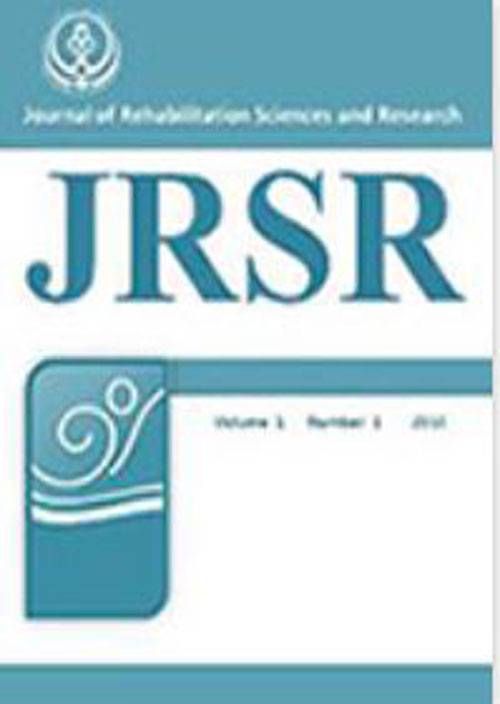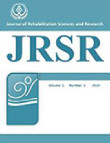فهرست مطالب

Journal of Rehabilitation Sciences and Research
Volume:8 Issue: 3, Sep 2021
- تاریخ انتشار: 1400/08/09
- تعداد عناوین: 8
-
-
Pages 101-105
Theory of Mind (ToM) is an essential component of communicationwith the others and social understanding. Cognitive structures, such as language,working memory, and executive functions play a special role in understandingthe others҆ minds. Thus, given importance of the role of language skills indevelopment of ToM and the previous research findings regarding the restrictedcapacity of children with cerebral palsy (CP) in development of their ability tounderstand others’ thoughts and feelings, this review study was designed tomainly evaluate the influence of language on ToM in children with CP.
MethodsFor this purpose, initially, electronic databases (PubMed, Scopus,PsycINFo, MEDLINE, Embase, and Web of Science) were searched fromSeptember 1 to 30 , during 2000-2020. Search was done focusing on the Englishwrittenpapers using a combination of keywords including: “Cerebral Palsy,Theory of Mind, Mentalization, and Language” to identify relevant studies from2000 to 2020.
ResultsA total of 978 publications were identified according to the initial searchcriteria. After reviewing abstracts, titles, and references of the identified papers,10 potentially relevant papers were selected. Based on assessing their full-text, 7papers completely met the inclusion criteria.
ConclusionGiven that children with CP have not been addressed by numerousinvestigations to date, there is limited information about their ToM skills andthe role of other different components of ToM development. Therefore, furtherresearch should be carried out to investigate this issue. The combined findingsof the reviewed papers showed that language skills had an effect on capacity toelaborate ToM competence in children with CP. This review study paves the pathto the future common research on children with CP and underlines importanceof using a methodology, in which ToM performance is studied in concert with adetailed investigation of speech and motor impairments.2021© The Authors. Published by JRSR. All rights reserved.
Keywords: Theory of mind, Language, cerebral palsy, Communication -
Pages 106-114BackgroundChronic non-specific low back pain (LBP) is one of the mostcontroversial issues of experts. Positive Ober`s test was considered a contributingfactor to LBP. Common intervention to address such problems was surgery oriliotibial band stretching. Recently, it was suggested that pelvic malalignmentis the contributing factor to Positive Ober`s test. Pelvic repositioning exerciseswas argued as a solution for the treatment of chronic LBP followed by pelvicmalalignment.MethodsIn this single-blinded randomized controlled trial, 18 patientsparticipated and were assigned into the control and treatment groups using theblock randomization method. One side Positive Ober`s test as an indicator ofpelvic malalignment was used as an inclusion criterion to employ the patientswho have pelvic malalignment and asymmetry. Patients were asked to completethe Oswestry disability questionnaire to assess their disability. Hip internal andexternal rotation and shoulder internal and external rotation ROM measured bya standard goniometer. An inclinometer measures hip adduction and abductionROM. Outcome measures were reassessed after 12 days. Data were analyzedusing the ANCOVA test to compare among groups.ResultsPatients in treatment group showed significant improvement of pain(P=0.01), ipsilateral hip adduction (P=0.00) and internal rotation (P=0.02)ROM and contralateral hip abduction (P=0.00) and shoulder internal rotation(P=0.00) ROM and Glenohumeral internal rotation deficit (GIRD) (P=0.001)compared with control group. There was no difference among groups fordisability (P=0.34) and contralateral hip external rotation (P=0.06) and alsothere was no difference for contralateral shoulder external rotation (P=0.85) andipsilateral shoulder internal (P=0.13) and external rotation (P=0.58).ConclusionPelvic repositioning exercises are an effective treatment to reducechronic LBP via improving pelvic alignment. These exercises improve GIRD andincrease shoulder internal rotation ROM, contralateral to positive Ober`s test.2021© The Authors. Published by JRSR. All rights reserved.Keywords: Low back pain, pelvic repositioning, pelvic alignment, pelvic orientation, Postural Restoration
-
Pages 115-120BackgroundStanding on an unstable platform needs more effort from neuromusculoskeletalsystem. This study was about to highlight the joint regulationsin keeping balance, while standing on an unstable platform using spectralanalysis.MethodsThirteen healthy young males were participated in this cross-sectionalstudy to stand on an unstable platform with two levels of support stiffness, twovisual, and three cognitive dual-task conditions. Motion analysis was utilizedto measure postural regulations at the lower extremity joints. Power spectralanalysis was applied on the joint rotations to discriminate the joint behaviors indifferent standing conditions.ResultsResults showed that the body used higher levels of postural adjustmentby more joint regulations as the standing conditions became more difficult.Support stiffness of the platform and vision were effective in keeping balance(p <0.05), while the dual cognitive tasks had no significant effect (P>0.05). Insimpler standing conditions, the ankle-hip strategy was responsible for bodystabilization in lower frequencies. However, increasing the standing difficultyby eliminating the vision or use of looser support of the platform was led to thepredominance of ankle strategy.ConclusionStanding in different conditions prevailingly relied on the anklestrategy. The enhancement of postural difficulty may revert to dominantly usethe ankle strategy.Keywords: Postural Balance, Joints, Visual feedback, Cognition
-
Pages 121-125BackgroundNormal aging is associated with many changes in speech-producing elements that can influence the articulators' ability to produce sounds quickly and precisely. To diagnose any motor problems in the oral area, it is necessary to obtain numerical oral motor performance rates in normal individuals. According to previous studies, quantitative measures of Oral diadochokinesis (DDK) vary across different cultures, languages, and ages. However, little research has been conducted in Persian native speakers to evaluate normal DDK in different age groups. Therefore, this study aimed to determine and compare DDK indicators in healthy young and older Persian native speakers.MethodsThe participants were 105 healthy young and older individuals (56 women and 49 men) with the age range18-40, 60-80, and >80 years. Each subject was asked to repetitively express the syllables 15 times, and the sequence /pataka/ 10 times. Mann–Whitney and independent-sample t-tests were applied to show the differences, respectively between and within age groups.ResultsThe significant difference was revealed between young and older groups in performance in all tasks (p=0.00). In younger participants, increasing age correlated significantly with increasing time needed to produce /ta/ (p=0.04) and /ka/ (p=0.01) syllables. Also, the rate variation decreased as the point of articulation moved backward in the vocal tract for /ta/ and /ka/ production in both the older (p=0.6) and younger group (p=0.4).ConclusionThe results of this study can also help clinicians to document differences in the articulation rate between older and younger people and diagnose abnormal oral motor rates.Keywords: verbal diadochokinesis, Speech diagnosis, older age, young
-
Pages 126-131BackgroundThis study aimed to investigate some child- and environmentdependentfactors in a retrospective method to find a prediction model for thespoken language development of children with hearing loss (HL) after cochlearimplantation (CI).MethodsThe research reported here was conducted as a cross-sectional pilotstudy. The sample size was 18 Persian 5-to-7-year-old children with HL usingCI (6 girls and 12 boys) who were recruited via consecutive sampling methodsfrom Soroush Rehabilitation Center in Shiraz, Iran. The studied independentvariables were categorized into child-related variables and parental variables.At the first step, the participants were divided into two groups, good languageability, and poor language ability, based on the results of Sentence RepetitionTest (SRT). The correlation between the independent variables and SRT scores ofthe groups were compared in two stages.ResultsRegarding the development of spoken language in two groups ofPersian-speaking preschool children using the cochlear implants with good andpoor language development, IQ, duration of watching TV, duration of playingwith the father, education status of the mother, education status of father,and economic status of the family had a significant correlation with languagedevelopment of these children.ConclusionAccording to this study’s findings, the child’s IQ, the duration ofwatching TV during the day, the duration of playing with the father during theday, the level of education of the mother, the level of education of the father, andthe economic level of the family may be considered the predictive factors in thelanguage development of cochlear implant children during the preschool years.Keywords: Cochlear implantation, Prediction, Language Development, outcomes, Persian
-
Pages 132-138Background
Approach on the diving springboard provides the initial conditionsfor the disturbance in the stability of the base of support. The present study is acorrelational study conducted to obtain complete and accurate information byexamining “the relationship between diving score and dynamic malalignmentof Hip, Knee, and Ankle on a 1 m springboard by elite male divers.”
MethodsIn the present cross-sectional study, the subjects of this study were the12 top divers of the Iranian League Championship in summer 2016. The passiveor reflective markers were attached to the posterior surface of subjects’ bodies.The subjects performed Forward Diving Straight (FDS) technique in one of twoways, either the “Hurdle Pre-Flight” or “Hurdle Flight”, and the head coachgave them scores. The x and y coordinates of each marker were estimated usingKINOVEA software. The relationship among the performance score of “FDS”and dynamic malalignment of Ankle, Knee, and Hip joints in the frontal planeat each step was determined using “Generalized Estimating Equation” (GEE)with the “Identity Function” and the “Normal Distribution”.
ResultsThe Results of GEE modeling showed that there was a significant inverserelationship between FDS score and “L. The mean ankle inversion in the (Hurdlepre-Flight) HPF approach was higher than Traditional (TRD). There was asignificant inverse relationship between the FDS score and “L. Hip Add.” Theresults of GEE modeling showed that there was a significant difference betweenmean scores of TRD-FDS (4.39±0.33) and HPF-FDS (5.67±0.33) approach(P=0.000)
ConclusionThere was a significant inverse relationship between FDS score and“Ankle Eversion/ Eversion, Knee and Hip Abduction/ Adduction” in Swing orStance Leg.
Keywords: Diving, Posture, Malalignment -
Pages 139-143BackgroundOccupational therapy outcomes for motor improvement aredifferent among the children with cerebral palsy to determine the effectivefactors related to gross motor achievement in the children with Cerebral palsy(CP), the present project was designed.MethodsIn a quasi-experimental study, 59 CP patients with Gross MotorFunction Classification System (GMFCS) 1-4 were evaluated by Gross MotorFunction Measure (GMFM). They were referred to four centers in Shiraz, Iran,in 2015. Results of therapy were monitoring five times during six months foreach participant, according to achievement to stages of GMFM, and marginalmodeling method was utilized.ResultsThe results revealed the significance of some factors including, age atstarting occupational therapy services, number of sessions per week, type ofspastic, level four of socio economic status (SES), grade two of GMFCS, and timeeffect on the outcome (upgrade to a higher level on each occasion) (p <0.05).ConclusionBased on the odds ratio (OR) values, the number of occupationaltherapy sessions per week had the most positive effect on gross motor functionupgrade for at least two half times. Age at starting occupational therapy servicewas the second important factor in the outcome. However, spending more timefor therapy and early starting relates to family characteristics and also financialsupport.Keywords: cerebral palsy, Gross Motor Function, Longitudinal studies, Prognosis
-
Pages 144-150BackgroundThis study investigated the effects of the aerobic exercise withmusic on anxiety, depression, motor proficiency, and cognitive ability of boyswith Attention Deficit Hyperactivity Disorder (ADHD).MethodsThis is a quasi-experimental study. Participant’s comprised aconvenience sample of 36 boys with ADHD. The experimental group (N=18)practiced in non-linear pedagogy (M years=11.32, SD=1.00), whereas the controlgroup (N=18) performed (M years=11.26, SD=0.92) usual school activities in thetraditional method.ResultsAfter participating in the 8-week aerobic training program, motorproficiency, anxiety, depression, working memory, perceptual reasoning, andprocessing speed were improved in the experimental group compared to thecontrol group (p <0.001).ConclusionBased on these findings, among the ADHD children, incorporatingmusic into sports can affect children’s anxiety, depression, motor proficiency,and cognitive ability. Increasing participation by incorporating music into sportssuch as aerobics, can affect children’s anxiety, depression, motor proficiency, andcognitive ability.Keywords: Nonlinear Dynamic, Anxiety, depression, Motor Skills, Attention deficit disorder with, hyperactivity


